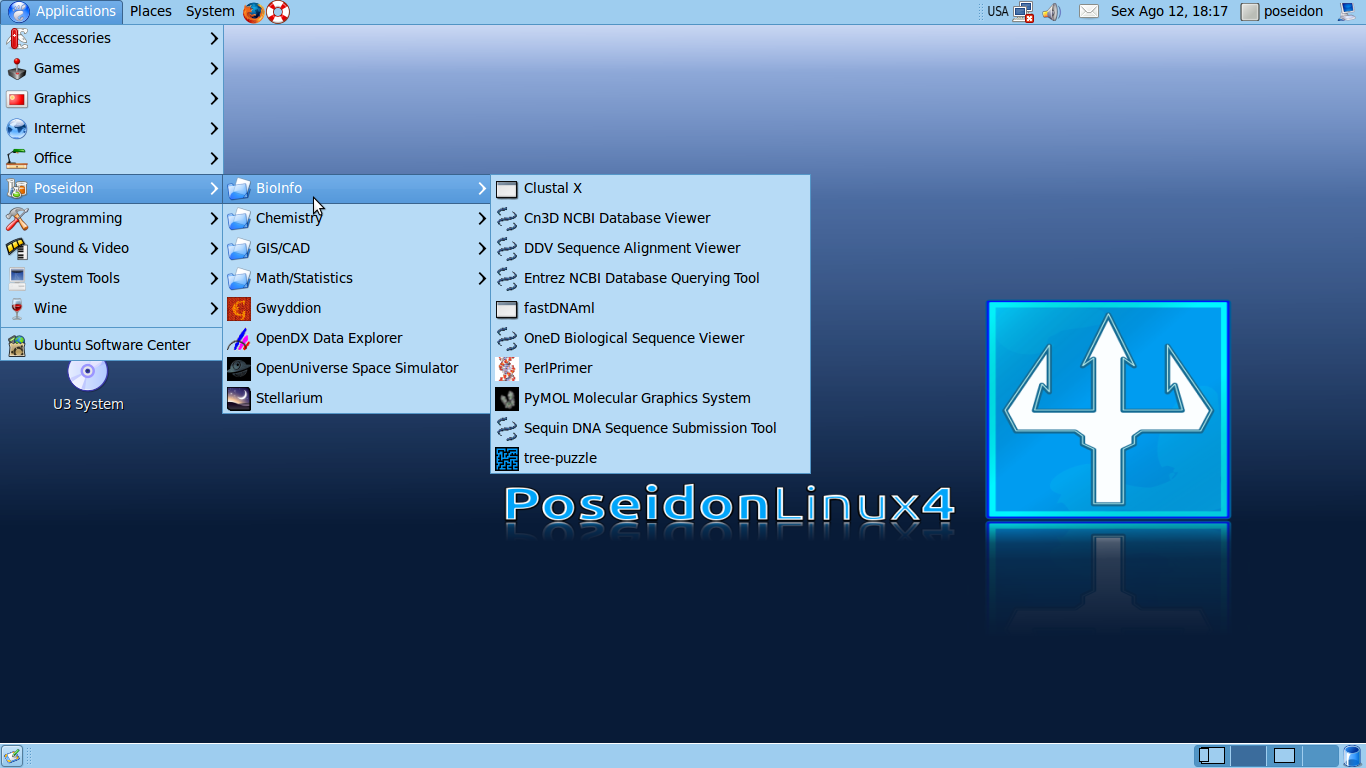Poseidon Linux is designed for the international scientific community, bundling a big batch of science-oriented software into a single live DVD, plus a batch of desktop productivity and multimedia applications. Poseidon 4.0 was just released with significant changes, so let’s take it for a test drive.
The Briny Deeps
Poseidon Linux is developed and maintained by scientists from the Rio Grande Federal University Foundation in Rio Grande do Sul, Brazil and other supporters all over the globe. It was named Poseidon because its development was driven by a school of oceanologists.
Poseidon was originally a derivative of Kurumin Linux. Kurumin is no more as it has been discontinued since 2008, but in its time it was a big deal that generated a lot of excitement and interest in Linux. Kurumin was a stripped-down Knoppix that fit on a mini-CD, with excellent hardware detection, a hard drive installation option (which the early Knoppix releases did not have), a beautiful appearance, and comprehensive documentation written in Brazilian Portuguese. Linux and FOSS are very popular in Brazil thanks to projects like Kurumin.
Poseidon moved to Ubuntu 8.04 LTS for its base in the 3.0 release, and has been based on Ubuntu ever since. It supports multiple languages: Brazilian Portuguese, Spanish, English, German, Greek, Italian, and French. The new 4.0 release is currently available only in a 32-bit version, with a 64-bit version promised soon.
 The new 4.0 release is based on Ubuntu 10.04 LTS, Lucid Lynx, which will be supported until April 2013. It uses a customized Gnome 2 desktop, and includes a big batch of biology, chemistry, GIS/CAD (geographic information system/computer aided design), and math and statistics software.
The new 4.0 release is based on Ubuntu 10.04 LTS, Lucid Lynx, which will be supported until April 2013. It uses a customized Gnome 2 desktop, and includes a big batch of biology, chemistry, GIS/CAD (geographic information system/computer aided design), and math and statistics software.
Figure 1: The attractive, calming blue Poseidon desktop
Installation and Going Inside
Installation, as with most Linux distros these days, is free of drama. The live DVD had no problem with my herd of laptops, which range from seven years old to brand-new, and it was happy on my test PC. It should be, because I carefully select all of my hardware to be Linux-compatible. The installer is the usual flexible Debian installer with multiple options.
The live DVD prompts you to log into Dropbox, or to create a Dropbox account every time it boots, because the nautilus-dropbox package is on the live DVD, so you’re stuck with the nag screens. You can easily get rid of this on a hard drive installation by removing the nautilus-dropbox package.
The live DVD is a conglomeration of languages. It defaults to the German keyboard, which is amusing if that’s not what you expect. It’s easy enough to change in System -> Preferences -> Keyboard -> Layouts. Just click the Add button and find your desired layout, and you can quickly check with the “Type to test settings” form at the bottom.
The default language for all the applications is English, though the panel clock was in Portuguese for some reason.
By default networking is not activated, and you can easily turn it on with Network Manager in the top panel.
Poseidon includes LibreOffice, but the LibreOffice splash screen is labeled BrOffice 3. I’m guessing this means Brazil Office, but I could not find out for certain.
It includes WINE for running Windows applications, and VirtualBox OSE for hosting other operating systems in virtual machines. It includes Unison, the excellent file-synchronization tool which makes a dandy backup utility. Also included are a nice complementary selection of publishing and typesetting applications: Lyx, Kile (graphical LaTex environment), KBibTeX bibliograpy editor, and the JabRef GUI fronted to BibTeX, and an assortment of graphical development tools such as Geany, Bluefish, Eclipse, and Qt4.
Why Another Respin?
Why a specialized science distro? Poseidon is more than just another Ubuntu respin because it includes a lot of specialized software that is not available in the Ubuntu or Debian respositories, and putting it all together in a nice distro is a real convenience. These extra packages are managed the usual way with Synaptic, Ubuntu Software Center, or apt-get, drawing from various repositories such as linux.dropbox.com/ubuntu, packages.medibuntu.org and ppa.launchpad.net.
You can see the repos that Poseidon uses in /etc/apt/sources.list.d and /etc/apt/sources.list. Medibuntu is the home for packages that cannot be included in Ubuntu because of copyrights, licenses, or patents. PPA is the personal packages archive for developers and enthusiasts who want to make packages available outside of the official Ubuntu distribution. linux.dropbox.com is used by a number of package maintainers for various distros for hosting their software downloads. You don’t need a Dropbox account to install software from this.
The Poseidon team bill it as “ideal for students, teachers, researchers, but also for any common (home) user.” I’m not so sure about this because it lacks many things that the popular general-purpose distros have, such as forums and mailing lists and documentation. The News page has no news, The News and Blog page is empty, and the linked Poseidon Linux’s Blog has not been updated since March 2009. Poseidon has an enthusiastic following, so perhaps they have their own private communications channels.
I give Poseidon a thumbs up for being a polished, nicely-put-together distribution. I wish it had documentation, user forums, or mailing lists, which are essential to any software project these days, FOSS or commercial.





